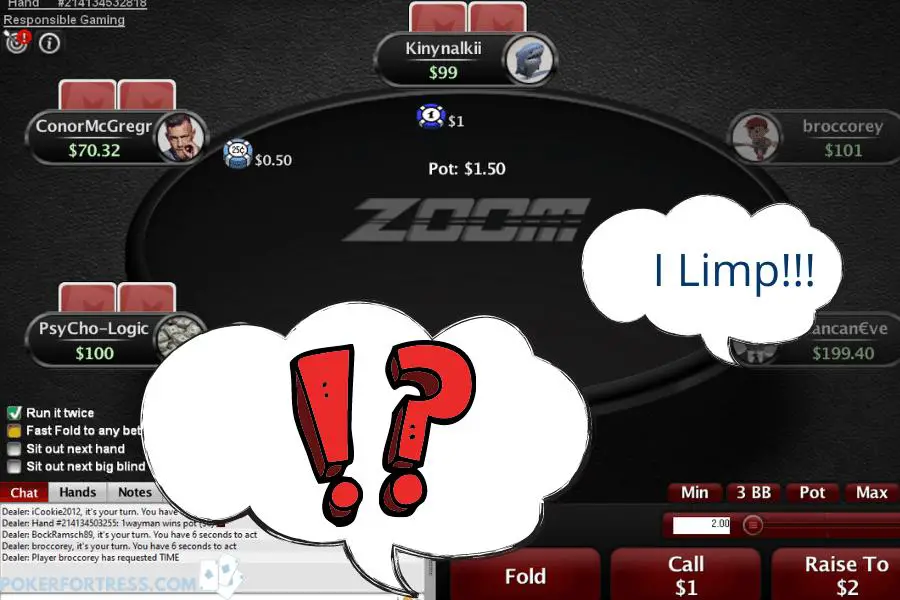Many of the things that we do at the poker table seem logical at first. However, some of these actions provide your opponents with so much data that they can use to crush you. One of these is limping—a move that professional poker players consider to be something that only weak, passive players do.
Limping refers to a move that only calls a bet instead of raising. When playing Texas Hold’em, open-limping refers to cold calling the big blind to enter the pot; over-limping is limping behind another limper. It’s not a good strategy because your chances of winning dwindle as soon as you limp.
There are several things that you need to know about limping, but we’ll discuss them in great detail. We’ll even share tips that can help you play better against limpers, and make sure that they become your most valuable customers.

Understanding the Basics of Limping
When playing Texas Hold’em, you have three moves when under-the-gun; you can fold, call, or raise. Professionals say that if you’re going to enter the pot pre-flop, your cards should be good enough for you to raise. If you flat call the big blind, it’s an open-limp. If the next player limps behind another limper, it’s called an over-limp.
Both moves seemed logical because a limper only wants to join the pot without committing a lot of chips. However, open-limping is never a good strategy because, aside from having a hand that isn’t good enough to raise, it drastically reduces the number of ways for a limper to win the pot. Over-limping, or limping behind other limpers, is a very different strategy that can be profitable at times.
We had to clarify the difference between the two because, throughout this post, we’ll be discussing open-limping, how it can affect your chances of winning, and how you can crush limpers in any game.
Why Is Open-Limping a Bad Move?
Have you ever wondered why some players seem to take advantage of other players pre-flop? One of the reasons is because weak players limp, and experienced players can read through it. Sure, there’s no harm in controlling the pot, but limpers will always have a hard time winning.
Open-limping one of the worst strategies that you can do when playing—stop doing it! Instead, it would be better to teach yourself how to find limpers and take advantage of their weakness to extract value from them.
Here are three of the biggest reasons why you should never limp in poker:
You Can’t Steal the Blinds
When you’re playing micro stakes, stealing the blinds is an essential strategy that you can use to create a steady profit. That’s especially true when you’re playing against passive players who will avoid confrontation and big pots.
If you limp, you’re not adding pressure to the table, and you’re not shaking off players who would fold. Since there’s no pressure, it’ll be easier for more players to take their chance at the flop.
If you limp, you immediately remove your chance of stealing the blinds. Let’s use this over-simplified scenario with only three players on the table:
- You’re the first to move, and you flat call the big blind. It seems logical because it’s pre-flop, and many players wouldn’t want to commit a lot of chips with a relatively weak hand.
- The next player to move is the small blind (SB), and 0.5x of your bet is negligible pressure. So even if he has a weak hand, it’ll be easier for him to join the pot.
- There’s no pressure for the big blind (BB) to get to the flop. He can join with a weak hand. Even if it’s remotely playable or a hand that he would typically fold if he needs to call a raise.
- If either the SB or BB raises the blinds, you’ll be in a tough spot. That’s because your hands are, most likely, not that strong. If you fold, you just let someone steal your bet.

When playing micro stakes, pre-flop is one of the best sources of steady profit. You don’t have to commit a lot of chips, and you only need to apply the right amount of pressure while managing your risks. However, if you limp, you instantly remove any chance for you to win the pot pre-flop.
One reason why a player limps is that he’s not confident with his cards. However, if you’re not that confident to raise your hand pre-flop, why would you even bother calling the big blind?
A rule of thumb pre-flop is never to play a hand that you’re not comfortable to raise, because, aside from not being able to steal the blinds, it also puts you in a tough spot post-flop.
You Can’t Gather Enough Data
Limping puts you in a neutral spot pre-flop, and that’s not a place where you want to be if you’re under-the-gun. In a nine max table, there’ll be eight other players who will make their moves after you. If you limp and one of the other eight players raises, you’ll be in a difficult spot. You’re also missing out on gathering as much data as you possibly can pre-flop.
If you raise the big blind, you’re taking yourself to the higher grounds, giving you a better view of other players’ moves. Let’s say you raise the big blind and another player re-raises; what does that tell you? It means that their hands are good enough to 3bet and add pressure to other players.
Raising the big blind gives you the chance to gather data from your opponents, but you won’t be able to take advantage of it if you limp.
Post-Flop Will Be Harder for You
Another reason why limping is never a good idea is because it’ll be harder for you to win the pot post-flop. Remember, when you’re playing micro-stakes, nitty players can stay with you on the flop if you don’t pressure them to fold.

As soon as you limp, you’re inviting all of your opponents to join the pot; therefore, there’ll be more players to look out post-flop. According to Partypoker, there’s only a 32.43% chance for someone to hit a pair at the flop; that’s a small percentage that many players wouldn’t be willing to call a raise pre-flop. Even pocket aces (AA) aren’t a big favorite to win against many opponents, and that’s what’s most likely to happen if you limp.
Limping makes it easy for everyone to enter the pot. Even the cards that you think is remotely playable will be at the flop because the “ticket” for entry is cheap. If you have T♥ 9♥, you wouldn’t call a raise of 3x the big blind, unless you’re playing loose. However, 1x the big blind is a small price to pay, even for tight players, for a 32.43% chance of hitting a pair by the flop.
Strategies to Crush Limpers in Cash Games
You already know that limping is never a good strategy, so let’s talk about how you can crush limpers. But before we start discussing the methods that you can use against limpers, always remember this:
Limpers are your most valuable customers. They will provide you with the most steady profit in all of your poker games.
There are three steps that you can do when playing with someone who limps a lot. Setting these strategies and combining them will provide you with a solid foundation in crushing limpers:
- Set a baseline for your strategy. Limpers have different reasons for limping, so it would be best to have the baseline on when it’s the best time to add pressure and how much of it you really need.
- Create a pre-flop strategy using your opponent’s baseline. The more you play with a limper, the more data you gather, and the easier it will be for you to counter their plays.
- Crushing a limper post-flop. The most effective way to crush a limper is to size your bet according to your cards while managing your risks.
Setting Your Baseline Strategy Against Limpers
It’s much easier if you’re playing against a friend, but if you really are his friend, you should be discouraging him from limping. However, in most cases, you don’t know what kind of limper you’re facing at the tables. He limps a lot, but we need to understand why. So we must set up our baseline when playing against one.
The most common type of limper that you’ll face at the felt is the “thinking type.” This player will limp with borderline hands that aren’t strong enough but is taking his chances to see the flop. Here are some examples of the hands that a limper would normally play:
- A4o or Ace 4 offsuit (A♥ 4♠)
- T9o or 10 9 offsuit (10♦ 9♣)
- A8s or Ace 8 suited (A♥ 7♥)
- K6s or King 6 suited (K♦ 6♦)
- T6s or 10 6 suited (10♠ 6♠)
- 65s or 6 5 suited (6♣ 5♣)
- Pocket 2 (2♠ 2♦)

These are examples of the hands that a typical limper will play. It’s playable, but not something that they’d be willing to raise. When facing a limper without a baseline, you want to play with a very tight range. If you do it, you can extract value from the limper, while gathering information about how he approaches limping.
Another reason is that weak hands may not be profitable because you’re still unsure whether he’ll limp-fold or play weak post-flop. As you play tight ranges, always keep an eye on how a limper plays his hands. Here are six things that you need to remember while setting up your baseline strategy against a limper:
- If a player tends to limp and fold after you raise, you can extract more value from him by iso-raising wider. However, if he folds less, you may have to play tighter to reduce your equity in the pot.
- If you’re playing with someone who limps, then re-raises (3bet), iso-raise tighter to manage your risks. When he is 3-bet less, it’ll be safer for you to loosen up and play wider.
- As you keep playing with a limper, you’ll have a better understanding of their limping range. If their range is getting wider, you can extract more value from him by iso-raising wider.
- When you’re in position, you can extract more value from a limper by iso-raising more than you would when you’re out of position.
- When you’re winning more hands against a limper, you’ll notice a change in their behavior. If they’re getting more aggressive, iso-raise tighter to manage your risks.
The more you learn about your opponent’s limping range, the easier it is to crush his stack. It’s all about creating a balance between managing your risks and extracting value—the best way to make money against limpers.
Choose Your Pre-flop Strategy Against Limpers
Players have different approaches against limping. Even a weak hand can be profitable against a limper if you play your hand correctly. But before we discuss the strategies that you can use against them in pre-flop, let’s talk about the variables that can affect your chances of extracting value from a limper.
Here are three variables that you have to consider before you take advantage of someone who limps:
- The skills of the limper. It’s the main reason why you have to set a baseline against a limper. It’ll be difficult if your opponent is limping with a balanced range.
- Tendencies and limping range. The decision-making process of a limper and his range can have a massive impact on how you can take advantage of his strategy.
- The other players at your table. If you’re playing with aggressive players, you don’t have to do all the heavy lifting in building up the pot. Small raises can still build up the pot without putting too much equity in the game.
- The number of chips that you have. It usually dictates the strategies that you can use when playing against a limper.
After you put all of these variables into consideration, it’s time for you to decide how you can play against a limper. Remember, this strategy tells you a lot about their hands, so you’ll have to size your bet according to your hands.
Play Tighter to Manage Your Risks
When you have a limper at your table, one move will tell you a lot about his hand. The biggest and something that you can actually use is:
“My hand is good enough for me to play from this position.”
That says a lot about the player, especially if you were able to set the baseline for your strategies against him. So when a player limps, you’ll have to worry about his hand, the players after you, the small blind, and the big blind.
It’s almost always a good strategy for you to play tight against a limper if the players after you have a high tendency to re-raise. Since they’ll always try to build up the pot themselves, you can extract more value from the table without giving yourself too much equity.
If the limper tends to limp-fold less and limp-3-bet often, you can manage your risks by playing tighter. It also helps you play effectively, even when you’re short on stacks, and you don’t have the positional advantage.
Play Loose With Inexperienced Players
In most cases, players who have a high tendency to open-limp pre-flop are inexperienced. They’re prone to making mistakes pre-flop or post-flop because their first move—to limp—is already a big mistake. So, they’re your best customers, and with proper aggression, you’ll be able to extract value from them.
Limpers make post-flop easier for you, allowing you to win pots that you’re not supposed to win—even when there are other players behind you. They’re weak, passive players, and the best way to take advantage of them is to force them to call your raise pre-flop. Remember, the reason why they limped is that they’re out of position or they have a weak range.
When you have the baseline against a limper and know that he doesn’t usually limp and then re-raise after you, it’s a good sign for you to play loose. By doing it, you can manage your risks and still extract value from your opponent effectively.
Another reason to play loose against an inexperienced limper is when you have a lot of chips and the players behind you are playing tight—they don’t usually re-raise. So, the only way to extract value from this kind of table is to build up the pot yourself and try to intimidate as many players as you can pre-flop.
Conclusion
Although there are some exceptions, limping will always be a bad strategy for many players. Even professionals will have a hard time pulling off this strategy in live cash games. It removes any chance for you to steal the blinds and possibly win the pot pre-flop.
The only time it’s good to limp is when you’re playing with a balanced range, and many people can’t do it. So, if you don’t want to get through the complexities of opening a balanced range for you to play, it would be best to avoid open-limping when you’re playing cash games.



